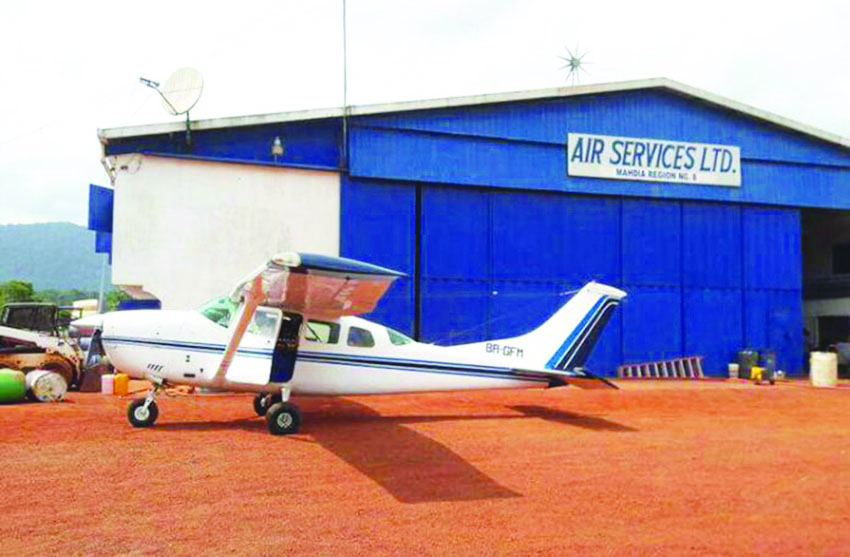Home News Bad weather, rough terrain delays pilot body transport
Region 8 plane crash
… GCAA to increase inspection frequency
…Govt concerned about increase aviation accidents — Harmon
The Guyana Civil Aviation Authority (GCAA) is expected to ramp up the frequency of its inspection of local aviation operations; and, in this regard, will be meeting on Wednesday with all operators to discuss safety issues in light of the recent spate of accidents that have occurred in the aviation industry. 
In the meantime, the body of 41-year-old Captain Imran Khan, a resident of the Essequibo Coast, Region Two, is yet to be flown to the city from the crash site. He had been attached to Air Services Limited (ASL), and had been flying from Chi-Chi to Mahdia when the Cessna 206 (8R-GFM) aircraft went down on Sunday.
Flying solo, Captain Khan had reportedly been expected to arrive at Mahdia at 08:47h, but had been a ‘no show’. An emergency locator transmitter (ELT) signal being emitted from the crashed aircraft and picked up at 09:08h was identified as coming from an area west of Mahdia.
A rescue operation involving the Guyana Defence Force’s 31 Special Forces Squadron was immediately mounted, but because of the mountainous terrain, search-and-rescue (SAR) operators had to trek to the crash site, where they found the lifeless body of Captain Imran Khan.
Because of time constrains, the rescuers had to stay with the body overnight at the crash site.
Captain Khan’s body was expected to be removed from the crash site and transported to Ogle, but reports out of the area indicate that weather changes have created difficulties for the rescue operators in transporting the body.
“We are awaiting word from the Special Forces, but there is heavy thunderstorm in the area and they are having difficulties moving with the body. They have to bring the body to a clearing where the helicopter could pick them up and fly them to the city,” Mrs Annette Arjoon-Martins, President of the National Air Transport Association, has said.
Investigation
Preliminary reports suggest that the aircraft may have crashed into a mountain before diving into the heavy jungle. The aircraft is badly mangled, and it is believed that Captain Khan may have been pitched from the plane following the impact.
Having launched an investigation into the fatal aircraft accident, the GCAA’s preliminary report has indicated that the plane was scheduled to land at Mahdia at approximately 08:47hrs, but failed to so do. A distress signal received at approximately 09:08hrs initiated a search operation by all domestic operators within the vicinity of the last known location of the aircraft.
The crash site was positively identified at 12:56hrs, and a team from the Guyana Defence Force was deployed to the area to recover the body of the pilot. Due to the conditions of the terrain, the rescue team had to trek for approximately 3 hours, cutting through thick vegetation, to reach the crash site from the landing zone.
The investigation by the Accident and Incident Investigation Group (AIG) will examine all possible circumstances that could have contributed to the occurrence of this latest accident, including weather conditions, pilot’s flight and duty hours, and the type of operations the pilot was conducting, the GCAA has said in a statement.
Upping the ante
The Director General of the GCAA, Lt. Col. (ret’d) Egbert Field, has said that surveillance and inspection of air operators, aircraft and other aspects of aviation operations will continue with more frequency.
The GCAA has commenced the State Safety Programme (SSP) as mandated by the International Civil Aviation Organisation (ICAO), and is presently at the implementation stage. The elements of the SSP were introduced to service providers at a workshop held in July 2017 as a precursor for the Safety Management System (SMS) which all operators are expected to implement.
Minister of State, Joseph Harmon, has said Government has mandated the GCAA to up its ante in relation to the inspections of aircraft and facilities.
“We have asked the Director of Civil Aviation for there to be more frequent levels of inspection of these aircraft, of the pilots and the facilities they use, to ensure that there is a higher level of safety in these operations. We, as a small country, cannot continue to lose young men in the prime of their lives to accidents. We are calling on the Director to increase [the] level of investigation and oversight over all of the operators, to ensure that the serviceability of these aircraft is checked, that the time and hours of the pilots which they fly, must also be checked, and this must not just be a one-off check, but a regular check and (done) also time and again; what we call ramp checks [random checks],” Harmon has said.
The Labour, Occupational Safety and Health Department has registered its concern “regarding the recent spate of industrial accidents which have afflicted the local aviation industry during the past 6 weeks.”
Chief Labour Officer, Charles Ogle, in a statement, said the law provides for the department to investigate and report on all accidents, whether fatal or not.
On August 8, a single-engine Cessna aircraft piloted by Captain Dominique Waddell was taking off from the Eteringbang airstrip in Region 7 when it crashed. The Wings Aviation plane was on a shuttling mission from Eteringbang to Ekereku when the incident occurred at around 11:00hrs.
A source close to the GCAA’s investigative team has said the recent plane crash at Eteringbang airstrip in Region Seven (Cuyuni-Mazaruni) on August 8 may be due to overloading.
On July 25, Captain Collin Martin, a retired Guyana Defence Force Major, was piloting a Roraima Airways aircraft when it crashed, killing him almost instantly.












